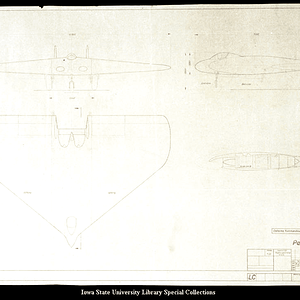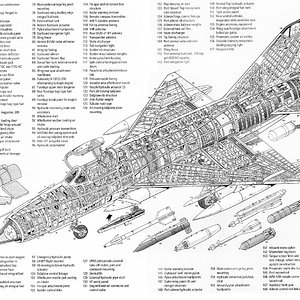Navigation
Install the app
How to install the app on iOS
Follow along with the video below to see how to install our site as a web app on your home screen.
Note: This feature may not be available in some browsers.
More options
You are using an out of date browser. It may not display this or other websites correctly.
You should upgrade or use an alternative browser.
You should upgrade or use an alternative browser.
P-11 V1
This project, belonging to the P11 series, was named also as Delta V1 and was one of the design classics to Dr Alexander Lippisch development during their stay at the Messerschmitt AG. After his departure from the former company on 28 April 1943, Lippisch continued with his work on the series P11 from 1 May 1943 in the new aviation Development Institute in Vienna (Luftfahrtforschungsantalt). An a full scale wood of the P11-121 model was built and inspected by a delegation from the Commission technical aeronautics of the Reich (Technische Luftrustung), and was by the absence of turbojet engines more reliable and powerful than the same not making was implemented.
After many improvements in its aerodynamics and on the technical side, including the installation of ailerons moving to improve stability and control, the project by the P11-121 as hunting not convinced to the technicians of the TLR, and was only after 1945 that this and other advanced projects of Lippisch reached the acceptance of the aircraft builders.
In his book Ein Dreieck Fliegt, Lippisch includes a diagram of three views of the project for Schnellbomber (fast bomber) P11-121 dated 17 May 1943, very simillar to the photo in this article, but two engines-driven I Jumo 004 turbojets (of 1,015 kg static thrust) c installed in the rear central interior of the fuselage, with a single tail empennage and engines equipped with deflection wings up and down at the exit of the engines in order to control the direction the Jet's thrust.
In this design is the front wheel forward in the nose under the driver and the wheels under the wings are saved replacement within each one of them; in the same van storage tanks of fuel with 1,200 kgs and 1000 kgs in the ventral central pump. P11-121 may 1943 has a 50 m wing area 2, length of laa of 10.6 meters, length of the fuselage of 6.8mts and a high of 2.7mts. A total weight of 2,400 kg and fully loaded 7.260 kg belica
The project was continued until December 1943 as a twin-engined fighter; a series of tests were conducted in the AVA Göttingen wind tunnel. For the initial prototype, will cancel the central Bay of the bombs and the two turbojets were replaced by units of solid fuel RATO, of 2.2 meters of length each, this P11 v1 central wheel housed in the fuselage to the rear. The model P11 V1, made of wood, was to fly initially as a glider, had to be abandoned before the advance of Russian forces. The Americans allegedly found it in a garage or cellar of the Grand Hotel in Strobl am Wolfgansgee.
Version P11 V2, contendrian wings 1,800 kg of fuel, equipped with engines turbojet Jumo 004 c, length of wing of 10.8 m, fuselage length 7 m, wing area of 50 m 2, total capacity of 3,600 litre fuel and load of 7,600 kg weight Estimated speed was 1,040 km/h to 19.685 feet, cruising speed of 850 km/h, range of 3,000 kms and a fixed armament of two MK 103 or a single large-caliber cannon.
This project, belonging to the P11 series, was named also as Delta V1 and was one of the design classics to Dr Alexander Lippisch development during their stay at the Messerschmitt AG. After his departure from the former company on 28 April 1943, Lippisch continued with his work on the series P11 from 1 May 1943 in the new aviation Development Institute in Vienna (Luftfahrtforschungsantalt). An a full scale wood of the P11-121 model was built and inspected by a delegation from the Commission technical aeronautics of the Reich (Technische Luftrustung), and was by the absence of turbojet engines more reliable and powerful than the same not making was implemented.
After many improvements in its aerodynamics and on the technical side, including the installation of ailerons moving to improve stability and control, the project by the P11-121 as hunting not convinced to the technicians of the TLR, and was only after 1945 that this and other advanced projects of Lippisch reached the acceptance of the aircraft builders.
In his book Ein Dreieck Fliegt, Lippisch includes a diagram of three views of the project for Schnellbomber (fast bomber) P11-121 dated 17 May 1943, very simillar to the photo in this article, but two engines-driven I Jumo 004 turbojets (of 1,015 kg static thrust) c installed in the rear central interior of the fuselage, with a single tail empennage and engines equipped with deflection wings up and down at the exit of the engines in order to control the direction the Jet's thrust.
In this design is the front wheel forward in the nose under the driver and the wheels under the wings are saved replacement within each one of them; in the same van storage tanks of fuel with 1,200 kgs and 1000 kgs in the ventral central pump. P11-121 may 1943 has a 50 m wing area 2, length of laa of 10.6 meters, length of the fuselage of 6.8mts and a high of 2.7mts. A total weight of 2,400 kg and fully loaded 7.260 kg belica
The project was continued until December 1943 as a twin-engined fighter; a series of tests were conducted in the AVA Göttingen wind tunnel. For the initial prototype, will cancel the central Bay of the bombs and the two turbojets were replaced by units of solid fuel RATO, of 2.2 meters of length each, this P11 v1 central wheel housed in the fuselage to the rear. The model P11 V1, made of wood, was to fly initially as a glider, had to be abandoned before the advance of Russian forces. The Americans allegedly found it in a garage or cellar of the Grand Hotel in Strobl am Wolfgansgee.
Version P11 V2, contendrian wings 1,800 kg of fuel, equipped with engines turbojet Jumo 004 c, length of wing of 10.8 m, fuselage length 7 m, wing area of 50 m 2, total capacity of 3,600 litre fuel and load of 7,600 kg weight Estimated speed was 1,040 km/h to 19.685 feet, cruising speed of 850 km/h, range of 3,000 kms and a fixed armament of two MK 103 or a single large-caliber cannon.








